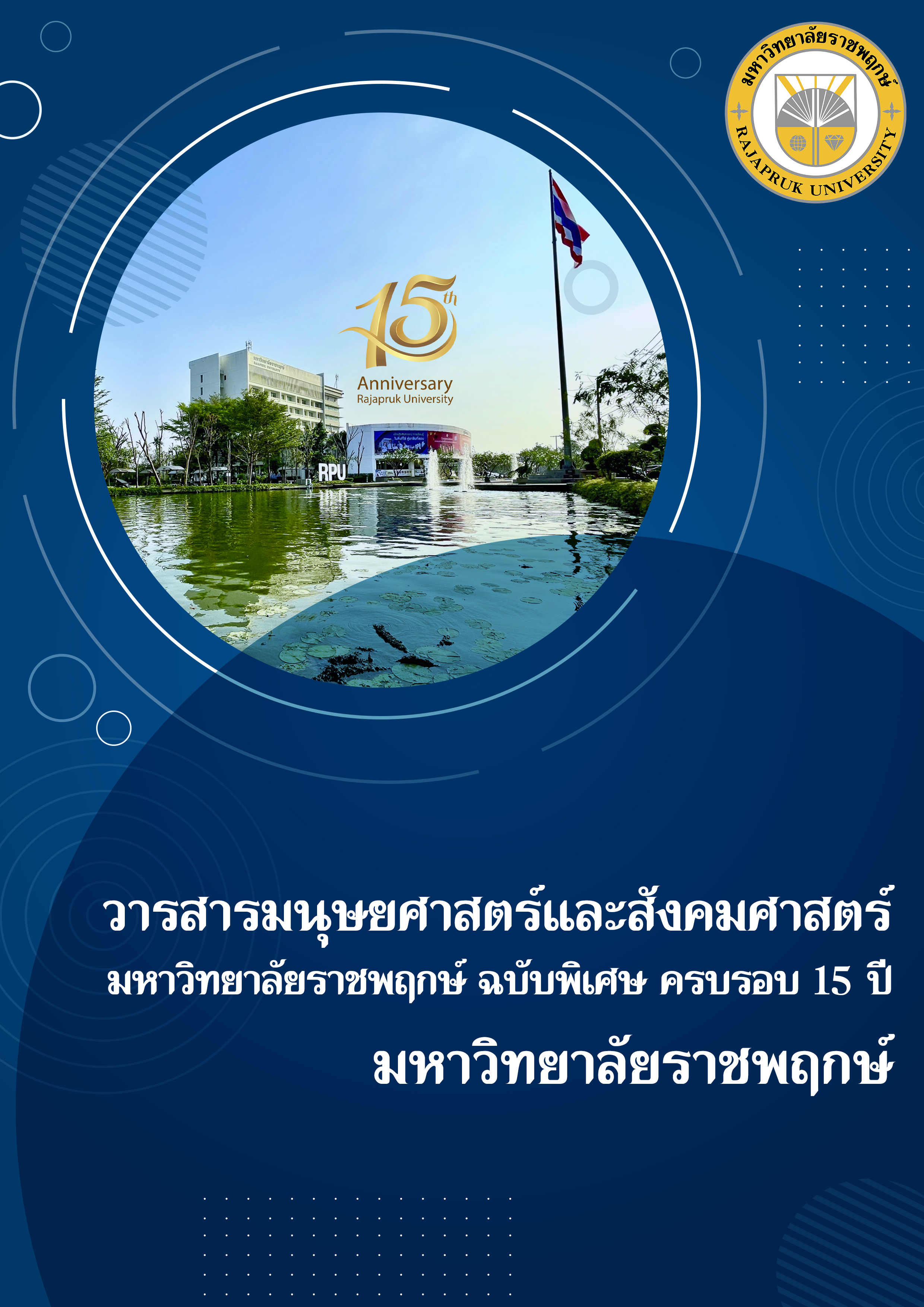Employees’ Organizational Commitment of Staff Members within Tasai Subdistrict Administrative Organization, Mueang Samut Sakhon District, Samut Sakhon Province
Main Article Content
Abstract
This research aims to study 1) the level of employee’s opinion in the strength factors of organizational commitment and employees’ organizational commitment of staff members within Thasai Subdistrict Administrative organization, Mueang SamutSakhon district, SamutSakhon province 2) were related to the level of the strength factors of organizational commitment and employees’ organizational commitment of staff members within Thasai Subdistrict Administrative organization, Mueang SamutSakhon district, SamutSakhon province. The sample were 142 persons who working within Thasai Subdistrict Administrative organization, Mueang SamutSakhon district, SamutSakhon province by using G*Power programs according to Cohen. The data is collected by using questionnaire estimation. The descriptive statistics used for this research are respectively percentage, mean, standard deviation and Pearson Correlation Coefficient.
Thses research findings revealed that 1) the level of employee’s opinion and the strength factors of organizational commitment that implemented in the employees organizational commitment within Tasai Subdistrict Administration organizational, Mueang SamutSakhon district, SamutSakhon province, in general was very good. In regard to each side, it was found that the mean of the aspect of social responsibility and the support of private and work life was the highest. These results were helpful to build the employees’ organizational commitment perception and also, in general was very good 2) the strength factors of organizational commitment that related to employees’ organizational commitment, in general, had the positive relations, the lower level. The Correlation Coefficient (r) was 0.423. Moreover, this research suggests that the positive relationships for studying the luck equation based on Darren Hardy the compound effect and quality of work life, including the employees’ organizational commitment for using in Tasai Subdistrict Administrative organization policy and planning in the next strategic year plan.
Article Details
References
ประสพชัย พสุนนท์. (2553). สถิติธุรกิจ. กรุงเทพฯ: ศูนย์วิทยบริการ สถาบันเทคโนโลยีไทย-ญี่ปุ่น.
ปรัชมิญช์ เหลาคำ. (2556). ความผูกพันต่อองค์การของบุคลากรในองค์การบริหารส่วนตำบลสองห้อง อำเภอเมืองบุรีรัมย์ จังหวัดบุรีรัมย์. การค้นคว้าอิสระปริญญามหาบัณฑิต มหาวิทยาลัยราชภัฏบุรีรัมย์.
พระศิวฤทธิ์ ชัยทน และ พินัย วิถีสวัสดิ์. (2560). ความผูกพันต่อองค์การของบุคลากรเทศบาลนครพิษณุโลก อำเภอเมืองพิษณุโลก จังหวัดพิษณุโลก. วิทยานิพนธ์ปริญญามหาบัณฑิต สถาบันเทคโนโลยีแห่งสุวรรณภูมิ.
สำนักงานคณะกรรมการมาตรฐานการบริหารงานบุคคลส่วนท้องถิ่น. (2556). ยุทธศาสตร์การพัฒนาข้าราชการส่วนท้องถิ่น พ.ศ.2557-2560 ในการเสริมสร้างธรรมาภิบาล. สำนักงานปลัด กระทรวงมหาดไทย. ค้นเมื่อวันที่ 10 ธันวาคม 2562, จาก http://www.local.moi.go.th/2009/home/NPM.pdf.
สำเริง เพ็งแก้ว สัญญา เคณาภูมิ และ ยุภาพร ยุภาศ.(2560). ปัจจัยที่ส่งผลต่อความผูกพันของบุคลากรองค์การบริหารส่วนตำบล ในอำเภอดอนสัก จังหวัดสุราษฎร์ธานี. วารสาร RMUGRC2017 มหาวิทยาลัยราชภัฏมหาสารคาม, 2: 1546-1555.
สุรศักดิ์ เพ็งภาค. (2559). วัฒนธรรมองค์การกับความผูกพันต่อองค์การของพนักงานองค์การบริหารส่วนตำบลประศุก อำเภออินทร์บุรี จังหวัดสิงห์บุรี. การค้นคว้าอิสระปริญญามหาบัณฑิต มหาวิทยาลัยรัชภาคย์.
อัญชลี ฝอยทอง. (2560). ความผูกพันต่อองค์กรของพนักงานองค์การบริหารส่วนตำบล จังหวัดนนทบุรี. กรุงเทพฯ: มหาวิทยาลัยปทุมธานี.
Affum-Osei, E., Acquaah, E. & Acheampong, P. (2015). Relationship between Organisational Commitment and Demographic Variables: Evidence from a Commercial Bank in Ghana. American Journal of Industrial and Business Management, 5: 769-778.
Ahmad, N. & Oranye, N. (2010). Empowerment, Job Satisfaction and Organizational Commitment: A Comparative Analysis of Nurses Working in Malaysia and England. Journal of Nursing Management, 18(5): 582-591.
AL-Jabari, B., & Ghazzawi, I. (2019). Organizational Commitment: A Review of the Conceptual and Empirical Literature and Research Agenda. International Leadership Journal, 11(1): 78-119.
Bluestone, I. (1977). Implementing Quality-of-work life Programs. Management Review, 6(9): 43-46.
Cohen, J. (1977). Statistical Power Analysis for the Behavioral Sciences. Rev. ed. New Jersey: Lawrence Erlbaum Associates, Inc.
Cohen, J. (1988). Statistical Power Analysis for the Behavioral Sciences. 2nd ed. New Jersey: Lawrence Erlbaum Associates, Publishers.
Cohen, J. (1992). A Power Primer. Psychological Bulletin, 112(1): 155-159.
Cronbach, L. J. (1990). Essentials of Psychological Testing. 5th ed. New York: Harper Collins Publishers.
Forkuoh, S. K., Affum-Osei, E., Osei, M. A. & Addo Yaw, V. J. (2014). Employees’ Commitment and Growth of Family Businesses. International Journal of Economics, Commerce and Management, 2(8): 1-14.
Geneviciute-Janoniene, G. & Endriulaitiene, A. (2014). Employees' Organizational Commitment: Its Negative Aspects for Organizations. Procedia-Social and Behavioral Sciences, 140(2014): 558-564.
Gupta, B. & Singh, A. (2015). Job Involvement, Organizational Commitment, Professional Commitment, and Team Commitment: A Study of Generational Diversity. Benchmarking An International Journal, 22(7): 1192-1211.
Gursoy, D., Maier, T. & Chi, C. G.-Q. (2008). Generational Differences: An Examination of Work Values and Generational Gaps in the Hospitality Workforce. International Journal of Hospitality Management, 27(3): 448-458.
Hardy, D. (2010). The Compound Effect. New York: Vanguard Press.
Judge, T. A., Heller, D. & Mount, M. K. (2002). Five-Factor Model of Personality and Job Satisfaction: A Meta-Analysis. Journal of Applied Psychology, 87(3): 530–541.
Kate, W. & Masako, T. (2002). Reframing Organizational Commitment within a Contemporary Careers Framework. New York: Cornell University.
Khalip, N. (2016). A Three-Component Conceptualization of Organizational Commitment. International Journal of Academic Research in Business and Social Sciences, 6(12): 16-23.
Likert, R.(1932). A Technique for the Measurement of Attitudes. Archives of Psychology, 140: 1-55.
McLeod, S. A. (2019). Qualitative VS Quantitative Research. Simply Psychology. Retrieved December 30, 2019, from https://shorturl.at/cquNT.
Meyer, J. P. & Herscovitch, L. (2001). Commitment in the Workplace: Toward a General Model. Human Resource Management Review, 11, 3, 299-326.
Sheldon, M. (1971). An Empirical Analysis of Organizational Identification. Academy of Management Journal, 14, 149-226.
Steers, R. M. (1977). Antecedents and Outcomes of Organizational Commitment. Administrative Science Quarterly, 22, 46-56.
Thoresen, C. J., Kaplan, S. A., Barsky, A. P., Warren, C. R. & de Chermont, K. (2003). The Affective Underpinnings of Job Perceptions and Attitudes: A Meta-Analytic Review and Integration. Psychological Bulletin, 129(6): 914–945.


